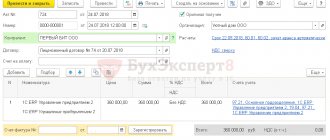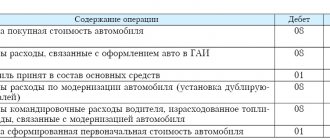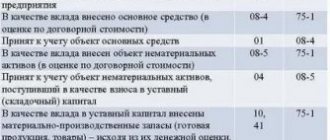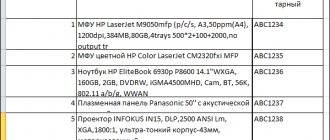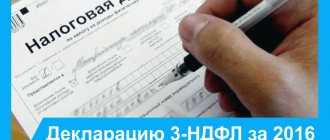Accounting for fixed assets at an enterprise in 2021 - 2021
First of all, accounting specialists at an enterprise should clearly understand the differences and similarities in approaches to reflecting fixed assets and transactions with them in the accounting and tax accounting of fixed assets.
In both accounting and tax accounting, in order for a company to consider certain equipment as its fixed asset, the object must meet the following criteria:
- the estimated period of use of the object exceeds 12 months;
- the object was acquired for use in the business of the enterprise, and not for resale;
- the asset is capable of bringing economic benefits to the enterprise;
- the initial cost exceeds 40,000 rubles. for accounting and 100,000 rubles. for tax accounting purposes.
ConsultantPlus experts explained in detail how to take into account fixed assets for income tax purposes. To do everything correctly, get trial access to the system and go to the Ready solution. It's free.
Until 01/01/2016, the criterion for the initial cost of fixed assets in accounting coincided with that in tax accounting: fixed assets were considered equipment worth more than 40,000 rubles. But from 01/01/2017 in paragraph 1 of Art. 256 and paragraph 1 of Art. 257 of the Tax Code of the Russian Federation, amendments were made, according to which OS began to be recognized for tax purposes only for property exceeding the value of 100,000 rubles. Moreover, this increase in the limit applies only to OS accepted from 01/01/2016. In accounting, the value of the limit has not yet changed: depreciable property is an asset worth more than 40,000 rubles. In this connection, taxable temporary differences are formed between tax and accounting.
See here for details.
Each fixed asset belongs to a specific depreciation group, and its cost is written off as expenses over a certain time period.
What applies to fixed assets
Fixed assets include property objects that are used for the production of goods, services, work, and management. Also included in this subgroup are used assets, assets in reserve, leased or under conservation. Also included in this subgroup in accounting are items of property whose operating period is more than 12 months.
In addition, funds that fall into the OS group must comply with the following standards:
The facilities are operated for the production and management needs of the enterprise, or are leased out.- The property was not acquired for the purpose of subsequent resale.
- The facility is capable of generating profit for the organization.
Thus, the OS subgroup includes buildings, structures, production equipment, machinery, computer equipment, household equipment, breeding livestock, perennial forest plantings, etc.
There is also another important criterion - cost.
PBU states that property can be regarded as fixed assets when its acquisition price is more than 40 thousand rubles. At the same time, in NU the cost of an object classified as fixed assets should be from 100 thousand rubles.
The procedure for accounting for the receipt of fixed assets in a company
When a company acquires (or receives) fixed assets, the task of accounting specialists is to ensure a correct reflection of the fact that the fixed assets have been received by the company, as well as the subsequent accounting of the fixed assets in the financial statements.
The first thing to do in this context is to determine the initial cost of the fixed asset. Therefore, it is important to know what this cost consists of.
As follows from paragraph 8 of PBU 6/01, the initial cost is determined by adding up all the costs that the company actually made in order to acquire the object and bring it to a state where it can be used in production, namely:
- Purchase price or construction price. If the operating system for the company was built by a counterparty, the costs can be confirmed using a transfer and acceptance certificate, invoice, work completion certificate, etc.
IMPORTANT! The price should be included in the original price excluding VAT. VAT is taken into account in the cost of fixed assets only if the company will use such fixed assets for VAT-free activities.
- Amounts spent on delivery of an object from the manufacturer (previous owner) to the company. For accounting, confirmation of this part of the initial cost of the fixed assets will be a waybill or waybill (when the company independently brought the fixed assets).
- The costs a company had to incur to make a facility suitable for use in production. This group of costs includes costs for installation, debugging, etc.
- If a company imported an asset from abroad, then customs duties and fees specified in the declaration can also be taken into account as part of the initial cost. This, in particular, was indicated by the Federal Tax Service of the Russian Federation in a letter dated April 22, 2014 No. GD-4-3/ [email protected]
- State duty, if its payment is necessary so that the object can be used by the company in production. Confirmation of such costs can be a simple payment order for payment of the duty.
- Any other costs that the company was forced to incur in connection with the acquisition of the operating system.
NOTE! The fundamental difference between accounting and tax accounting is that it allows you to take into account in the initial cost of an investment asset interest on loans that the company had to take out in order to acquire such an asset (clause 7 of PBU 15/2008, approved by order of the Ministry of Finance of Russia dated October 6, 2008 No. 107n). In tax accounting, interest is always a non-operating expense.
You can find out what are the nuances of accepting real estate for accounting and tax accounting from the Ready-made solution from ConsultantPlus. Trial access to the legal system is free.
An example of the formation of the cost of fixed assets in accounting based on 1C ERP version 8.3 is presented below:
All expenses associated with the acquisition and/or construction of fixed assets are reflected in the debit of account 08.04 and are controlled by the “Account Card” report.
After a company specialist calculates the total initial cost of the fixed assets, such an object can be taken into account. To do this, the company should issue an OS acceptance and transfer certificate, and then open a special inventory card for the object.
IMPORTANT! The company should be aware that even if the OS needs to be registered with government authorities, this procedure will not affect the moment of acceptance for accounting. In any case, such a moment occurs on the date when the initial cost of the fixed asset is determined.
Accounting depending on the methods of receipt of fixed assets
Accounting for each fixed asset occurs differently; the method depends on the official source from where the fixed asset came to the enterprise. Different paths not only lead to different initial costs, but also different accounting nuances.
- Purchasing from a supplier. It is necessary to take into account all costs, including transport and installation, excluding VAT. According to accounting, this will be done in this way:
- the cost of the acquired asset excluding VAT (debit 08, credit 60);
- additional costs for delivery, installation, setup, etc. (debit 08, credit 60 or 76);
- allocation of VAT (debit 19, credit 60 or 76);
- putting the main asset into operation (debit 01, credit 08).
- Acceptance under a gift agreement. It is necessary to take into account the market price of the object, current at the time of donation (the amount must be documented).
ATTENTION! Entrepreneurs and organizations cannot make “gifts” to each other in amounts exceeding 5 minimum wages.Accounting entries:
- D08 K98/2 - the main asset was received free of charge and accepted for accounting;
D01 K08 - this material asset is put into operation;
- D98/2 K91 - writing off depreciation from account 98 to “other income”.
- Contributing your share to the authorized capital. The cost of the OS is agreed upon by the founders and regulated in the constituent documents.
NOTE! If funds are deposited for a significant amount exceeding 200 times the minimum wage, then it must be additionally assessed by an independent specialist.Accounting data:
- the property asset is introduced as a contribution to the authorized capital (debit 08, credit 75);
the main asset is put into operation (debit 01, credit 08).
- Creating an OS in-house (economic method, construction, etc.) - all costs for raw materials, the work itself (if necessary, then under contracts), transportation costs, installation, etc. are subject to accounting. Accounting:
- wages for contractors (debit 08, credit 60 or 76);
- cost of raw materials (debit 08, credit 10);
- all other costs incurred in creating the operating system (debit 08, credit 60 or 23, 25, 26, 76);
- allocation of VAT for all types of expenses (debit 19, credit 60 or 23, 25, 26, 76);
- putting a new asset into operation (debit 01, credit 08).
- Receipt under contracts where the remuneration provides for obligations other than monetary – the cost is determined in the same way as when transferring an object as a gift (based on the current market price for similar goods or services). Accounting entry:
- acceptance of funds for accounting (debit 01, credit 08);
- the asset is accounted for and put into operation (debit 01, credit 08).
Depreciation and revaluation of fixed assets in accounting
The company depreciates the OS over the course of its operation, i.e., gradually transfers its value to account 02.
NOTE! Depreciation in accounting for the operating system used should not be interrupted. An exception exists only for OS preserved for more than 3 months, as well as for OS, the restoration of which should last longer than 12 months (clauses 17, 23 of PBU 6/01).
However, accounting specialists should remember that some categories of fixed assets do not need to be depreciated. These include, for example, land plots.
For information on how to calculate depreciation and display it in accounting, read the material “Methods of calculating depreciation in accounting.”
The company also has the right to revaluate its fixed assets, that is, recalculate both the cost of fixed assets and the amounts of previously accrued depreciation. This follows from clause 15 of PBU 6/01. Such revaluation must be carried out at the end of each year. In this case, the results of revaluation (the value of revaluation or discount) can both influence the financial results of the company and increase/decrease the company’s additional capital.
How to formalize the revaluation of OS in practice, read in the Typical situation from ConsultantPlus. If you do not have access to the K+ system, get a trial online access for free.
For more information about the revaluation of fixed assets, see the article “Why is the revaluation of fixed assets necessary?” .
Obsolescence
This type of wear shows the loss of effectiveness of using the OS before the end of its STI. It is divided into two categories: the first and second types.
Obsolescence of the first type manifests itself due to a decrease in the cost of the OS, due to cheaper analogues. Calculated as follows:
I = (Фп – Фв) / Фп, in this case
- Fp – initial price of OS
- Fv – replacement cost (or costs of purchasing an analogue)
Obsolescence of the second type is associated with the emergence of analogues with greater productivity. It can be complete, partial and hidden.
Complete – depreciation, as a result of which its further use will lead to losses in production.
Partial implies the loss of part of the price of the OS fund.
Hidden is a rare occurrence. Represents a decrease in the price of the OS, in connection with an order to produce new equipment with greater productivity and efficiency.
When calculating obsolescence of the second type, one should evaluate the feasibility of purchasing new equipment to replace outdated equipment. The calculation is made using the formula:
I = 1 – (Ts/Tsu), in which
- C – cost of the product on outdated equipment (y)
- (c) in modern
These indicators are calculated as follows:
C = Fp / (P x T) P, while
- P – performance of an obsolete item
- Fp – initial cost
- T – remaining SPI
Registration of fixed assets is a responsible and important stage of accounting. Its careful execution guarantees the accuracy, transparency and relevance of the company's accounting.
Top
Write your question in the form below
Organization of accounting for the sale of OS
If a company decides to sell an operating system, then the accounting specialist has the task of correctly showing the fact of sale in the financial statements. What are the accounting consequences of selling an asset?
1. On the date of sale (transfer of ownership rights to the new owner), the selling company should record income. Such income is taken into account as part of other income and accumulated in account 91 (on the loan).
IMPORTANT! Income is only the net sales price, excluding VAT. However, all income is first credited to account 91, after which the amount of VAT on fixed assets is reflected by posting to the debit of account 91 in correspondence with account 68.
How to calculate VAT on the sale of fixed assets can be found in the publication “Calculation and procedure for paying VAT on the sale (realization) of fixed assets.”
2. The sale of fixed assets entails the need to attribute the residual value of such fixed assets to other expenses of the company.
Find out about the features of accounting for the sale of fixed assets here.
In terms of documenting the sale of OS to a company, it should be remembered that the fact of transfer of OS to the buyer is recorded in an acceptance certificate.
Registration of receipt of fixed assets for a fee
The price of an asset purchased under a purchase and sale agreement is made up of the company’s actual costs directly for the acquisition (manufacturing), transportation and bringing the asset to a normal condition for operation. It also includes amounts paid to contractors and consultants, non-refundable and customs fees/duties, and fees to intermediaries.
When purchasing an OS, the initial cost is “collected” in the debit of the account. 08 from credit accounts 60, 76, etc.
Example 1
The company purchased the machine for 360,000 rubles, incl. VAT 20% – 60,000 rub. Delivery of the machine cost the company 30,000 rubles. excluding VAT, and installation and commissioning costs 12,000 rubles. without VAT. The accountant completed the purchase with the following entries:
Operations D/t K/t Sum Purchased a machine 08 60 300 000 VAT included 19 60 60 000 Costs taken into account: — on transportation 08 76 30 000 - on commissioning and commissioning 08 76 12 000 VAT is accepted for deduction 68 19 60 000 The machine was put into operation (300,000 + 30,000 + 12,000) 01 08 342 000
In the same way, the cost of an object constructed (manufactured) on its own is formed - using an economic method. In addition to settlement accounts, the formation of the price of an asset will also include costs associated with its creation, for example, materials, personnel salaries, deductions, wear and tear of equipment used in the formation of new property, etc. – D/t 08 K/t 02, 10, 23, 69, 70. When constructing an investment asset, its value may include interest on long-term and short-term loans – D/t 08 K/t 66.67.
What is important to remember when selling unfinished properties
In practice, cases often arise when a company decides to sell an unfinished future OS, for example, a warehouse or building. Here you should also remember some accounting features.
In particular, income from the sale of such unfinished objects is also considered other income and is credited to account 91 in the amount that the buyer paid for the object.
However, since the unfinished object has not yet been recognized by the company as fixed assets, it does not have a formed initial value. The question arises as to what should be included in expenses.
IMPORTANT! As indicated by paragraphs. 11, 14.1, 16, 19 PBU 10/99, approved by order of the Ministry of Finance of the Russian Federation dated May 6, 1999 No. 33n, in this situation, in other expenses (debit of account 91), the company should include those costs that it has already incurred in connection with the construction of the operating system ( the actual value of the object as of the date of sale), as well as, if relevant, costs associated with the sale (for example, intermediary fees, etc.).
As in the case of the sale of fixed assets, when selling an unfinished object, income arises (and is shown in the reporting) on the date when ownership rights transferred to the acquirer.
What is an inventory object
The acquired property must be defined as fixed assets; this process implies:
- registration
- assignment to the depreciation group in accordance with the regulations
If an object is a complex of several objects or devices, then difficulties may arise. For example, a building or structure is classified as an inventory object. The definition states that an inventory object is a completed device, object or complex of objects, which includes all the devices and devices that belong to it for the purpose of performing its intended functions.
It is possible to determine what exactly belongs to the object as an integral part using documentation, technical certificates, etc.
Inventory objects can be simple or complex, that is, consisting of more than one item. In addition, they are registered with the enterprise and assigned an inventory number.
Nuances of accounting for the transfer of fixed assets to the authorized capital of an LLC
If a company decides to transfer its former OS to the authorized capital of another organization, it should be remembered that such a transfer must also be formalized by an appropriate act. It can be compiled either in free form or using a template in the OS-1 form. At the same time, it is important that such an act reflects the residual value of the fixed assets, as well as the amount of VAT that the company will have to recover in connection with the transfer of the fixed assets as a contribution to the capital of another company.
Further. The transferred OS is assessed by the participants of the receiving organization to determine the size of the contribution made by such OS. Therefore, it is important for the company to understand that if participants evaluate the fixed assets at a cost exceeding its book value, then the company will attribute the difference to its income (credit to account 91 in correspondence with the debit of account 76, intended to account for the company’s debt on a contribution to the capital of a third-party company). In the opposite case, if the shareholders valued the operating system at a smaller amount than what was indicated in the company’s accounting documents, it turns out that in fact the debt on the contribution to the capital company was not fully repaid. Therefore, the difference should be included in other expenses and written off as a debit to account 91.
Whether to charge depreciation on fixed assets received as a contribution to the management company, read here.
Property as a contribution to capital
If an enterprise received OS as a contribution to its authorized capital, the initial cost is determined in the form of a monetary valuation agreed upon by the founders. This rule is provided for by PBU 6/01 (clause 9). Here, however, it should be taken into account that in an LLC, for example, the amount agreed upon by the founders cannot be higher than the assessment of an independent appraiser, despite the fact that his involvement upon receipt of a non-monetary contribution to the capital of the company is, according to clause 2 of Art. 66.2 of the Civil Code, mandatory.
When registering a fixed asset transferred as a deposit, the accountant makes the following entry:
- Dt sch. 08 Kt sch. 75.
Please note that when receiving an asset from a VAT payer enterprise, the recipient has the right to deduct the tax presented, previously recovered by the transferring entity.
Let's look at an example. Let’s assume that the company received equipment valued by the founders at 160 thousand rubles as a contribution to capital. This assessment turned out to be equal to the value established by an independent appraiser. VAT amounted to 23 thousand rubles.
The table shows the entries that an accountant will make when registering a fixed asset.
| Operation | Debit | Credit | Sum |
| Receiving equipment as a contribution | 08 | 75 | 160 thousand rubles. |
| Accounting for VAT presented by the transferring entity | 19 | 83 | 23 thousand rubles. |
| Acceptance of tax deduction | 68 (subaccount “VAT”) | 19 | 23 thousand rubles. |
| Registration of fixed assets | 01 | 08 | 160 thousand rubles. |
Liquidation of fixed assets in accounting
Liquidation of fixed assets has some peculiarities in terms of accounting.
Firstly, since the company did not receive income for the disposed fixed assets, the company will only have to show expenses in its accounting. In this case, expenses (recorded in the debit of account 91) will include the following:
- residual value of the liquidated asset;
- the amount of costs for work (both own and performed by third parties) that directly accompanied the liquidation of the OS;
- the amount of VAT that the company had to restore in connection with the liquidation of the operating system.
What transactions are made when disposing an asset , see . in the material “Disposal of fixed assets in accounting (nuances).”
Secondly, specialists responsible for fixed assets accounting should not forget that as a result of liquidation, the company receives some new inventory. They must be taken into account on account 10 (debit) in correspondence with the increase in the company’s other income (credit 91).
Read about how to take into account costs when liquidating an OS here.
Example of fixed asset accounting
- An example of purchasing a tractor for cash and how to register the tractor:
An agricultural enterprise purchased a tractor worth 150,000 rubles in cash for production work. Additional transportation costs amounted to 15,000 rubles. We balance the tractor:
- Dt08 Kt60(76) 150,000 rub. — cost of the tractor;
- Dt08 Kt60 15,000 rub. – costs of transporting the tractor;
- Dt01 Kt08 RUB 165,000 – the tractor is accounted for at its original cost;
- Dt60(76) Kt50 165,000 rub. – all expenses to the seller have been paid.
The useful life of a tractor according to the classifier is 10 years. This means that the depreciation of the tractor is: 165,000/120 (months) = 1,375 rubles. per month.
Dt02 Kt01 1375 rub. – calculation of monthly depreciation.
- An example of purchasing a tractor free of charge:
A tractor was given to a peasant farm free of charge (donation agreement), the market value in accounting will increase the income of future periods. We make the following entries:
- Dt08 Kt98.02 – accounting for the cost of a tractor transferred under a donation agreement;
- Dt08 Kt10(70.60...) – additional costs associated with receiving the tractor and putting it into operation;
- Dt01 Kt08 – put into operation.
When calculating depreciation, the proportional part of the cost allocated to account 98.02 is written off to account 91.
When transferring a tractor for rent or for free use, there is no need to put the asset on the balance sheet. It will be accounted for in off-balance sheet account 001.
We must not forget that after the reporting year it is necessary to calculate and pay property tax.
In order to calculate property tax, the tax base will include the cadastral value, not the residual value.
Accounting for the presence and movement of fixed assets in a company must be enshrined in the Regulations on Accounting Policies. Then it will be easier to prove to the tax authorities that the accounting of income and expenses for fixed assets is correct.
The purchase, rental, gratuitous use and other types of receipt of fixed assets are closely related to the further generation of profit and are taken into account in accounting as part of income receipts in tangible assets.
Results
Accounting for fixed assets in 2021 should, for the most part, be carried out in the same order as before.
Namely, to take into account the operating system on the date of bringing it to a state of readiness for operation. Subsequently, when selling the OS, the remuneration received is included in income, and the residual value of the OS is included in expenses. Similar rules apply to the sale of unfinished properties. At the same time, it is important for specialists to remember: despite the fact that in tax accounting the cost criterion for recognizing an asset has increased to 100,000 rubles, in accounting it has not changed and is still 40,000 rubles. You can find more complete information on the topic in ConsultantPlus. Free trial access to the system for 2 days.
Physical deterioration
Physical wear and tear is a decrease in the original value of property for the consumer. It is calculated in two ways, see table 2.
| Name | Description | Formula | Decoding |
| Based on scope of work | It is suitable for items with established performance | I = (Tf x Pf) / (Tn x Pn) | Tf – time that the object actually served Pf – average quantity of products produced per year Tn - SPI according to the norm Mon – normal productivity |
| By period of use | It is established by comparing the actual and normative SPI. Valid for determining the wear and tear of any OS. |
Calculation formulas on video:
